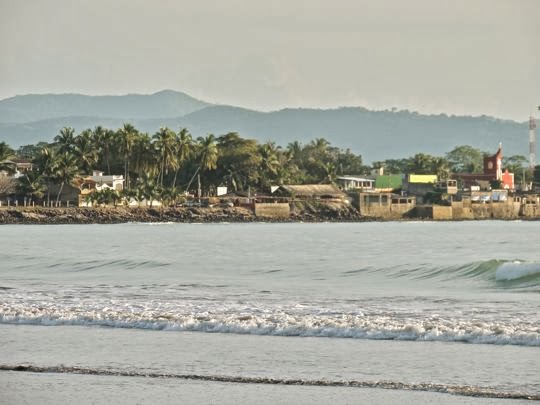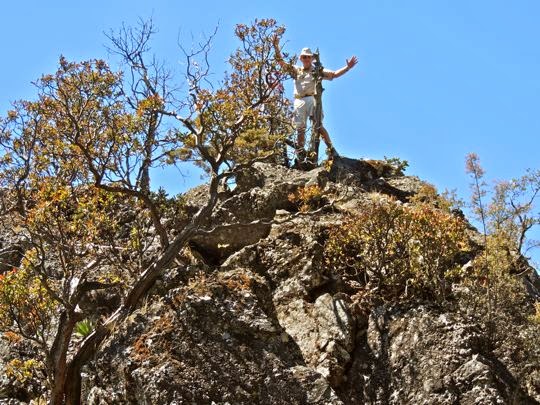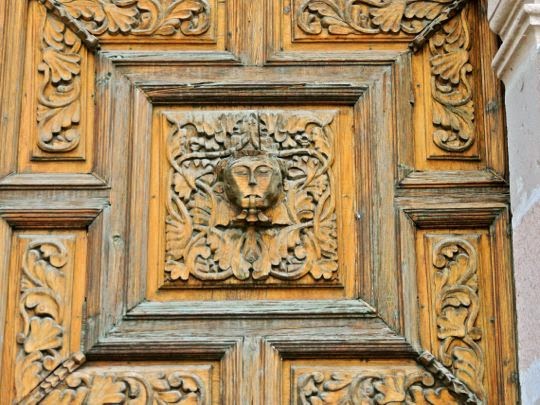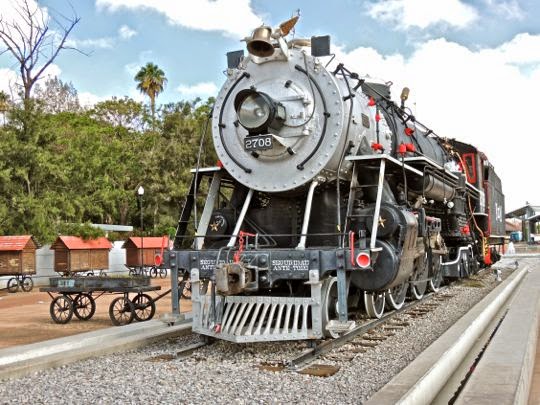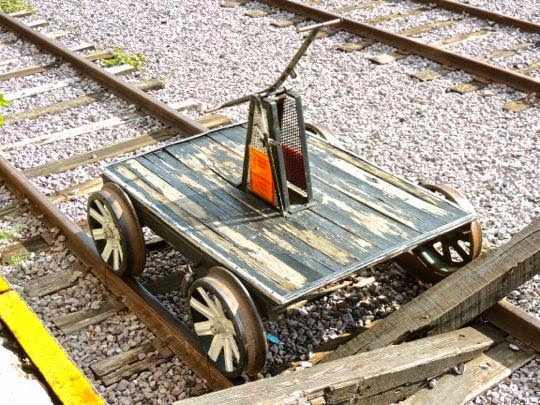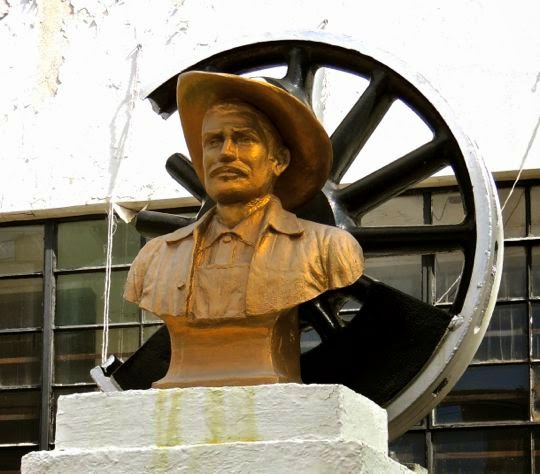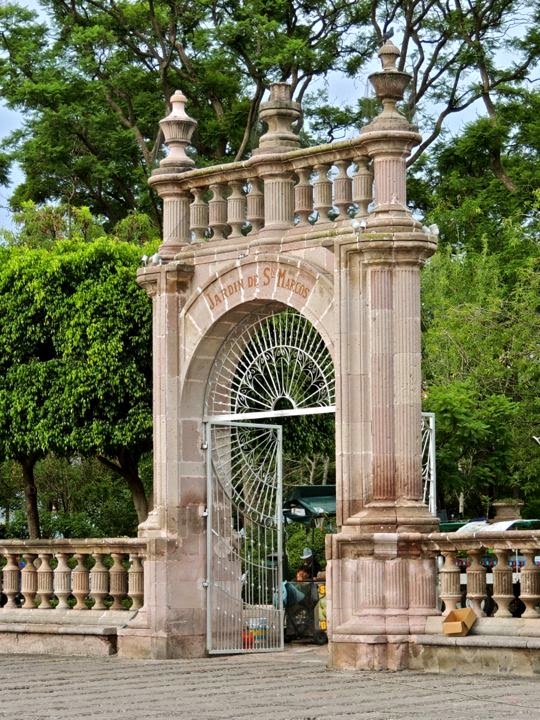The Upper Falls of Yerba Buena Gorge drop nearly vertically down to a pool at the bottom. The pool lies in the cul-de-sac of a remote canyon with sheer sandstone walls hundreds of feet high. As my long-time blog fans know, every fall for the last five years I join a group of expat hikers for a trek to one of the most dramatic waterfalls of Lake Chapala's South Shore. Afterward, we return for a fiesta at the home of Raul and Geronima, a local farming couple who live in the little pueblo of Citala near the trailhead. This October, we visited the Yerba Buena Gorge, a site I have shown in previous blog postings. However, we used a route that we discovered only recently, one which provides spectacular vistas not only of the waterfall, but of the valley and mountains as well. Part 1 of this two part series covers the area from the trailhead to the Upper Falls. Part 2 will cover the trail from the falls back down to the little pueblo of Citala, where our Raul and Geronima live.
From the trailhead along the west side of Yerba Buena Gorge
Our hiking party at the trailhead. We traditionally take a group shot like this at the start of one of our hikes. Including me, there were eight in our party. From left to right are Larry, Stephanie, Chuck, Eileen, Gary, Jim B, and Tomas. All except Stephanie are hikers who are experienced in the rugged mountains around Lake Chapala. Again, except for Stephanie, the "kid" of the group, all of us are retirees in our sixties.
View looking north over the plateau and outer canyon. Lake Chapala's South Shore mountains are in the background. The Lake is just beyond them. The flat cultivated area at the center of the photo is the West Plateau. Just to the right of center you can see a "V" shaped canyon. This heavily jungled trench cuts due south through the plateau to the entrance Yerba Buena gorge. The East Plateau lies to the right of the V. The pueblo of Citala is to the left of the smoke, in the valley between the plateau and the mountains.
Cow bones littered this part of the trail. This is cattle country and the muddy trail was cut up by their hoof marks. When a large animal like a cow or a horse dies in this rugged area, it is left where it falls. This is true even if the carcass lies across a trail. The local people who use these backcountry paths simply divert around it until the scavengers have picked the body clean and scattered the bones. This is simple practicality. Moving the body would require more effort than it would be worth.
The first part of the trail was a bulldozer road. Although a steady uphill climb, it was easy hiking. Seen with Stephanie, Chuck, and Eileen is the ninth member of our hiking party. Matty is a regular member of our group, at least when Chuck comes along. I hesitate to describe Chuck as Matty's owner, since he himself describes her as his best friend. She adores hiking with us almost as much as she adores Chuck. Matty makes it a point to greet and make friends with each hiker of any group she accompanies. I call her the "Gangster of Love" because she is so expert at stealing your heart.
View across the outer canyon to the East Plateau. Notice the line of cliffs where the plateau drops off into the heavily wooded canyon. The cliffs are higher than they appear because the bottom part is hidden by foliage. The tops of both the East and West Plateaus are covered with a checkerboard of fields. Some are for pasture, but others are planted with corn, beans, mallow, or other crops. All of the fields are small, measuring only a few hundred meters on a side, at most. Generally they are bordered by dry stone walls, made with the debris of old volcanic eruptions. Some of the farmers have planted cactus along these field borders as a sort of natural barbed wire. The cactus helps discourage cattle or horses from browsing among their crops.
(Left to right) Jim B, Gary, and Larry pick their way up a rocky slope. After the short bulldozer road ended at the start of the bluffs, a narrow, overgrown trail led up toward the mouth of the Gorge. Notice the sticks that Larry and Gary are carrying. Virtually all of the experienced hikers I know carry some sort of hiking pole, and some carry a pair. The trails in these mountains are very stony and require you to choose your footing carefully. Some of the trickiest spots are sloping stretches with small pebbles. Traversing these is something akin to walking across slick glass covered with ball bearings. Hiking sticks are essential to avoid falls--and inconvenient injuries--in country like this. They also serve to push thorny branches away from exposed arms and legs. I keep several extra poles handy in case hikers new to the area come without them.
Looking north out of the mouth of the Yerba Buena Gorge. The East Plateau can be seen in the upper left. We hiked south along the upper part of the west face of the inner Gorge. After we visit the Upper Falls, we will loop around behind them and return on the trail heading north along the east face of the Gorge. The east face can be seen on the right side of the photo above. The Gorge walls are several hundred feet high and the lower two thirds are nearly vertical. In most places along the bottom, the inner Gorge is only 30-50 meters wide, but it slopes back a bit at the level of the trail we are traveling. If you look at the East Plateau above, you can see a cleared fleld with a horizonal line of vegetation crossing it. When we emerge from the forest on the east face, we will follow this line of vegetation until we meet a farm road that will bring us down off the plateau and into Citala.
Jim B (rt.) and Gary (lft.) approach a giant pitayo cactus. This one is quite old. It stands about 10 meters high and probably weighs a couple of tons. Sometimes we find giants like this fallen across the trail. We are always glad we weren't under them when they crashed down. The fruit of the pitayo, called the pitaya, is sweet and juicy. The local people collect them from the tips of the cactus' arms, using long poles with a wire hook on the end. Pitaya are sometimes sold in the local street markets, as well as being gathered for personal consumption. Lake Chapala is located in an ecological transition zone between jungly coastal areas and the high deserts of Jalisco. That is why you see cactus growing in a lush deciduous forest like this.
Sheer cliffs line the east face of the inner Gorge. Our return trail will lead from right to left along the top of these cliffs. The Gorge has two large waterfalls, in addition to several smaller ones. The base of the Lower Falls (out of sight to the right) is reached directly from the bottom of the canyon. I have shown the beautiful Lower Falls and its box canyon in a previous posting. Currently, there is no route known to expat hikers which leads from the base of the Lower Falls up to the base of the Upper Falls. The higher cascades can only be viewed from above. The Upper Falls canyon has tantalized us for years but entering it will require some serious technical rock climbing and rope work. It is not clear how, once in, one can then get out again.
Larry (left) and Tomas (rt.) cut their way through the ever-thickening forest. It was during the dry season when we last used this route and the trail was then clear and dusty. After the rains of summer, the forest reclaimed the area. As a result, we lost our route several times. Many of the hiking regulars carry garden shears and folding hand saws for times like this, and with some effort we managed to hack our way through and get our bearings. The jungle seemed to grow even as we were cutting it.
Across the canyon, we could see the result of a massive derrumbe (rockslide). I used my telephoto to bring this much closer than it actually is. A huge chunk of the cliff face, perhaps 7 meters high x 7 meters wide (21 ft x 21 ft), and 1 to 2 meters thick (3 to 6 ft), has dropped away. Many tons of rock cascaded down the cliffs, finally crashing into the canyon bottom. This derrumbe appeared quite fresh and was probably triggered by the rains of the past couple of months. Looking up as all this tumbled down at you would not be a comfortable experience. Fortunately, it appeared that our return trail ran along the cliffs above the slide, rather than below it. Otherwise, I feared our cliffside path might contain a huge gap.
Jim B ducks a low-hanging branch. These can be an annoyance and sometimes a real hazard. Most of us wear broad-brimmed hats which shield the eyes from glaring sun, but can also hide obstacles like this. Many, including myself, can tell stories about hiking along at a good fast clip while focusing on the ground in search of hidden, potentially ankle-twisting rocks. Suddenly, BANG! We run headfirst into an overhang like this. You can rest assured that it smarts a bit. Usually we tag the hazard with strips of the brightly-colored plastic tape we use for route markers.
A visit to the Upper Falls
Our trail leads down to a creek which flows to the Upper Falls. The creek flows to the left, and about 50 meters or so in that direction the water makes the long drop into the pool far below. The cafe-au-lait color of the water is due to agricultural runoff. The creek originates from a large reservoir on the wide plateau that stretches south from the top of the bluffs we have just climbed. Beginning with the valley where Citala is located, the land rises in a series of stepped plateaus like a broad east-to-west natural staircase. The bluffs into which the Yerba Buena Gorge cuts are like the risers between steps on this great staircase. Over the millenia, water flowing from the upper plateaus to the lower ones, and then into the valley, has cut the Gorge and the outer canyon, finally emerging at Citala.
Crossing the creek required some boulder-hopping. The streams of the North Shore of Lake Chapala are bone dry for 9 months of each year, but those of the South Shore carry water year-round. The rubber pipe running diagonally across the photo is for the purpose of water collection. While the water in the creek is not potable, hoses like this collect drinkable water from springs in the canyon.
The Upper Falls overlook, with a view down the Gorge toward Lake Chapala's mountains. While Larry relaxes against a tree, Tomas peers over the edge toward the pool. A few inches in front of his left foot is a ledge that drops off straight down at least 50 meters (150 ft) or more. The mouth of the Upper Falls is below and to the left of Tomas, out of view unless you hang over the edge.
From the trailhead along the west side of Yerba Buena Gorge
Our hiking party at the trailhead. We traditionally take a group shot like this at the start of one of our hikes. Including me, there were eight in our party. From left to right are Larry, Stephanie, Chuck, Eileen, Gary, Jim B, and Tomas. All except Stephanie are hikers who are experienced in the rugged mountains around Lake Chapala. Again, except for Stephanie, the "kid" of the group, all of us are retirees in our sixties.
View looking north over the plateau and outer canyon. Lake Chapala's South Shore mountains are in the background. The Lake is just beyond them. The flat cultivated area at the center of the photo is the West Plateau. Just to the right of center you can see a "V" shaped canyon. This heavily jungled trench cuts due south through the plateau to the entrance Yerba Buena gorge. The East Plateau lies to the right of the V. The pueblo of Citala is to the left of the smoke, in the valley between the plateau and the mountains.
Cow bones littered this part of the trail. This is cattle country and the muddy trail was cut up by their hoof marks. When a large animal like a cow or a horse dies in this rugged area, it is left where it falls. This is true even if the carcass lies across a trail. The local people who use these backcountry paths simply divert around it until the scavengers have picked the body clean and scattered the bones. This is simple practicality. Moving the body would require more effort than it would be worth.
The first part of the trail was a bulldozer road. Although a steady uphill climb, it was easy hiking. Seen with Stephanie, Chuck, and Eileen is the ninth member of our hiking party. Matty is a regular member of our group, at least when Chuck comes along. I hesitate to describe Chuck as Matty's owner, since he himself describes her as his best friend. She adores hiking with us almost as much as she adores Chuck. Matty makes it a point to greet and make friends with each hiker of any group she accompanies. I call her the "Gangster of Love" because she is so expert at stealing your heart.
View across the outer canyon to the East Plateau. Notice the line of cliffs where the plateau drops off into the heavily wooded canyon. The cliffs are higher than they appear because the bottom part is hidden by foliage. The tops of both the East and West Plateaus are covered with a checkerboard of fields. Some are for pasture, but others are planted with corn, beans, mallow, or other crops. All of the fields are small, measuring only a few hundred meters on a side, at most. Generally they are bordered by dry stone walls, made with the debris of old volcanic eruptions. Some of the farmers have planted cactus along these field borders as a sort of natural barbed wire. The cactus helps discourage cattle or horses from browsing among their crops.
(Left to right) Jim B, Gary, and Larry pick their way up a rocky slope. After the short bulldozer road ended at the start of the bluffs, a narrow, overgrown trail led up toward the mouth of the Gorge. Notice the sticks that Larry and Gary are carrying. Virtually all of the experienced hikers I know carry some sort of hiking pole, and some carry a pair. The trails in these mountains are very stony and require you to choose your footing carefully. Some of the trickiest spots are sloping stretches with small pebbles. Traversing these is something akin to walking across slick glass covered with ball bearings. Hiking sticks are essential to avoid falls--and inconvenient injuries--in country like this. They also serve to push thorny branches away from exposed arms and legs. I keep several extra poles handy in case hikers new to the area come without them.
Looking north out of the mouth of the Yerba Buena Gorge. The East Plateau can be seen in the upper left. We hiked south along the upper part of the west face of the inner Gorge. After we visit the Upper Falls, we will loop around behind them and return on the trail heading north along the east face of the Gorge. The east face can be seen on the right side of the photo above. The Gorge walls are several hundred feet high and the lower two thirds are nearly vertical. In most places along the bottom, the inner Gorge is only 30-50 meters wide, but it slopes back a bit at the level of the trail we are traveling. If you look at the East Plateau above, you can see a cleared fleld with a horizonal line of vegetation crossing it. When we emerge from the forest on the east face, we will follow this line of vegetation until we meet a farm road that will bring us down off the plateau and into Citala.
Jim B (rt.) and Gary (lft.) approach a giant pitayo cactus. This one is quite old. It stands about 10 meters high and probably weighs a couple of tons. Sometimes we find giants like this fallen across the trail. We are always glad we weren't under them when they crashed down. The fruit of the pitayo, called the pitaya, is sweet and juicy. The local people collect them from the tips of the cactus' arms, using long poles with a wire hook on the end. Pitaya are sometimes sold in the local street markets, as well as being gathered for personal consumption. Lake Chapala is located in an ecological transition zone between jungly coastal areas and the high deserts of Jalisco. That is why you see cactus growing in a lush deciduous forest like this.
Sheer cliffs line the east face of the inner Gorge. Our return trail will lead from right to left along the top of these cliffs. The Gorge has two large waterfalls, in addition to several smaller ones. The base of the Lower Falls (out of sight to the right) is reached directly from the bottom of the canyon. I have shown the beautiful Lower Falls and its box canyon in a previous posting. Currently, there is no route known to expat hikers which leads from the base of the Lower Falls up to the base of the Upper Falls. The higher cascades can only be viewed from above. The Upper Falls canyon has tantalized us for years but entering it will require some serious technical rock climbing and rope work. It is not clear how, once in, one can then get out again.
Larry (left) and Tomas (rt.) cut their way through the ever-thickening forest. It was during the dry season when we last used this route and the trail was then clear and dusty. After the rains of summer, the forest reclaimed the area. As a result, we lost our route several times. Many of the hiking regulars carry garden shears and folding hand saws for times like this, and with some effort we managed to hack our way through and get our bearings. The jungle seemed to grow even as we were cutting it.
Across the canyon, we could see the result of a massive derrumbe (rockslide). I used my telephoto to bring this much closer than it actually is. A huge chunk of the cliff face, perhaps 7 meters high x 7 meters wide (21 ft x 21 ft), and 1 to 2 meters thick (3 to 6 ft), has dropped away. Many tons of rock cascaded down the cliffs, finally crashing into the canyon bottom. This derrumbe appeared quite fresh and was probably triggered by the rains of the past couple of months. Looking up as all this tumbled down at you would not be a comfortable experience. Fortunately, it appeared that our return trail ran along the cliffs above the slide, rather than below it. Otherwise, I feared our cliffside path might contain a huge gap.
Jim B ducks a low-hanging branch. These can be an annoyance and sometimes a real hazard. Most of us wear broad-brimmed hats which shield the eyes from glaring sun, but can also hide obstacles like this. Many, including myself, can tell stories about hiking along at a good fast clip while focusing on the ground in search of hidden, potentially ankle-twisting rocks. Suddenly, BANG! We run headfirst into an overhang like this. You can rest assured that it smarts a bit. Usually we tag the hazard with strips of the brightly-colored plastic tape we use for route markers.
A visit to the Upper Falls
Our trail leads down to a creek which flows to the Upper Falls. The creek flows to the left, and about 50 meters or so in that direction the water makes the long drop into the pool far below. The cafe-au-lait color of the water is due to agricultural runoff. The creek originates from a large reservoir on the wide plateau that stretches south from the top of the bluffs we have just climbed. Beginning with the valley where Citala is located, the land rises in a series of stepped plateaus like a broad east-to-west natural staircase. The bluffs into which the Yerba Buena Gorge cuts are like the risers between steps on this great staircase. Over the millenia, water flowing from the upper plateaus to the lower ones, and then into the valley, has cut the Gorge and the outer canyon, finally emerging at Citala.
Crossing the creek required some boulder-hopping. The streams of the North Shore of Lake Chapala are bone dry for 9 months of each year, but those of the South Shore carry water year-round. The rubber pipe running diagonally across the photo is for the purpose of water collection. While the water in the creek is not potable, hoses like this collect drinkable water from springs in the canyon.
The Upper Falls overlook, with a view down the Gorge toward Lake Chapala's mountains. While Larry relaxes against a tree, Tomas peers over the edge toward the pool. A few inches in front of his left foot is a ledge that drops off straight down at least 50 meters (150 ft) or more. The mouth of the Upper Falls is below and to the left of Tomas, out of view unless you hang over the edge.
The view while hanging over the edge. The drop is mostly vertical and much of it through open air so a lot of the water reaches the bottom as mist. The circular pool can be seen at the lower right. To take this shot safely, I had to lie down on the flat shelf while poking my camera's lens over the edge. Accidentally toppling over the edge here would be, in a very real sense, jumping to a conclusion.
A front view of the falls. This was taken from further down the return trail. Our perch was located above and to the left of the top of the falls. The water continues to drop behind the screen of foliage, finally reaching the brown pool at the bottom. Similar to the Lower Falls, the Upper ones drop into a narrow box canyon surrounded by vertical sandstone walls.
A telephoto view of the pool at the bottom of the Upper Falls. As you can see, the vertical walls rise right out of the water. There is very little scree (rock rubble) around the rim of the pool. Except for the difficulty of reaching it, and the unknown quality of the brown water, it looks like a great spot for a cool dip on a hot day.
Chuck and Matty at the edge of the Upper Falls overlook. This was a gorgeous spot to hang out for a bit so we broke out our mid-day snacks and some water. After observing Matty on a number of hikes, I have come to the conclusion that she takes as much pleasure in a beautiful view as her human hiking buddies do.
Cliff walls of the Upper Falls' cul-de-sac. There are shallow caves here and there in the walls. When Raul first brought a group of us here, he told a story about a man who stole a large amount of money from the hacienda where he worked. Local legend has it that he buried his treasure somewhere in this cul-de-sac, possibly in one of the caves. Various attempts have been made to find it, none of them successful, for which I'm glad. A setting like this deserves a story about a (still) long-lost buried treasure.
An epiphytic bromiliad grows out of a crevice on the side of a cliff.These plants draw their nutrients from the air, rain, and small debris that may collect around their wiry roots. I often find bromiliads attached to rock walls, tree limbs, telephone lines and many other odd places. When they attach themselves to another plant, the relationship is not parasitic, but simply one of hitching a ride.
Paxtle is another kind of epiphytic plant. Paxtle(Tillandsia recurvata) is related to Spanish Moss. The plant is collected by indigenous people for use in their ceremonies, sometimes serving as "hair" for dancers wearing hideous masks. Recent research has indicated that paxtle may have a beneficial effect on patients with tumors and HIV/AIDS.
Stephanie enjoys an orange. Stephanie and Tomas were the only hikers among us who don't live full-time at Lake Chapala. She is an acquaintance of Chuck who was visiting from the US and decided to take him up on his offer to join us for some hikes in the local mountains. Tomas spent a year as a Peace Corps volunteer in the Bosque Primavera, a large forest adjacent to Guadalajara. He is a seasoned and rugged long-distance hiker who is back on a visit.
This completes Part 1 of my two-part series on our 5th Annual Waterfall Hike and Corn Fiesta at Raul's. In the next part of this series we will travel the trail from the Upper Falls along the east side of the Gorge. Along the way, we'll take in the gorgeous views of Mt. Garcia and the valley at its base. Then we'll head down to Citala where we'll meet Raul and Geronima, our hosts for the fiesta. I always appreciate feedback, questions, and constructive criticism. If you would like to leave a comment, click on "No Comments" at the bottom of this page.
If you leave a question in the Comments section, PLEASE leave your email address so I can respond.
Hasta luego, Jim



























































































































